A few months after starting a former job, I attended a workshop in which we discussed our brand promise.
It was a clarifying moment for me — despite having a solid mission and vision statement, it was the brand promise that really defined the heart of the company and what my role was.
![Free Kit: How to Build a Brand [Download Now]](https://cdn.iranwebsazan.org/iranwebsazan/2024/10/814dd420-0d49-40e0-b59c-f01066e186c1.png)
A brand promise isn‘t just a tagline — it’s a way to show customers what your brand can offer that no one else can.
Like other kinds of promises, brand promises can get complicated. They set high expectations, offer ambitious commitments, and impact relationships.
Let’s talk about what a brand promise is, how to create a brand promise, and see examples from popular B2B and B2C brands. We’ll also share a brand promise template to help you draft your own.
Keep reading or jump ahead to the section you’re looking for:
- What is a brand promise?
- Why Your Brand Promise Is Important
- How to Write a Brand Promise
- What makes a brand promise successful?
- Brand Promise Template
- Brand Promise Examples
- Examples of Brand Promises for B2B
Your brand promise should be central to your company, something that remains constant even as the company grows and evolves.
Not every brand promise is explicit — it could also be more of an internal mantra that’s shared with employees, investors, and partners.
But if you’ve built a strong brand identity and clear messaging, your brand promise will be evident to your target audience. (And if you’re still working on your brand identity and messaging, we’ve got a free guide to help.)
Brand Promise vs. Tagline
There‘s often some confusion between a brand promise and a tagline, so let’s break it down.
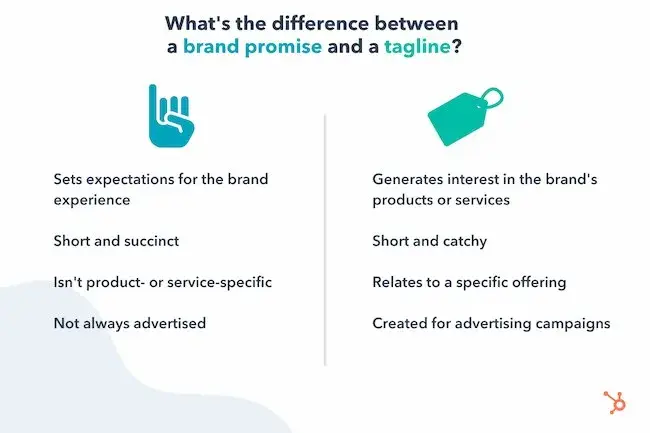
While it can be just as short as a tagline, a brand promise establishes and nurtures a relationship with consumers by telling them, “Hey, this is what you can expect every single time you interact with our brand.”
A brand promise isn’t lofty — it’s grounded in the realities of your business. It can:
- Help internal and external stakeholders know what to expect from you.
- Gain consumer trust.
- Be the foundation for your company’s consumer interactions.
A Quick Brand Promise Definition
Brand promises are short statements. They make a commitment to your customer about what your brand will deliver.
It is a promise, after all. So if you break it, it can affect your reputation and your revenue.
For instance, let‘s say your brand promise is “Innovation at every turn,” but your company hasn’t released a new product in five years. That can deter potential consumers who have been promised progress but instead get stagnation.
Here are the most common types of brand promises:
- Emotional: A promise appealing to emotion.
- Action-based: A promise tied to a specific action.
- Social: A promise based on ethical or social responsibility.
Why Your Brand Promise Is Important
This message can have a big impact on customer sentiment, brand reputation, and more. A brand promise is a social contract between your company and the customer or consumer.
You may not have a legally binding document swearing that your company will innovate at every turn, but it’s understood that consumers are giving you something (like their hard-earned money) in exchange for a product or service.
It’s the scaled, commercial version of a pinky promise, with your brand holding up one finger and your target audience holding up the other.
And if you’re not taking your brand promise as seriously as a legally binding document, you’re at risk of losing not just your customers, but your market valuation, employees, and other stakeholders.
Delivering on your brand promise can help your business grow by building trust with your target audiences and boosting sales.
But how can you pack all that power into a single message? Let’s talk about how to create your brand promise.
How to Write a Brand Promise
1. Focus on your audience.
Your brand promise outlines your commitment to your audience. So, to figure out what your promise should be, your first step is determining what your audience wants from you.
It goes beyond a specific product or service, it‘s more specific to the experience you’re providing.
For instance, Planet Fitness’s brand promise is based on people’s reluctance to join the gym for fear of judgment and embarrassment. The Planet Fitness brand promises to create an environment that encourages people at all fitness levels to go to the gym and feel comfortable working out.
Another goal of your brand promise is to set you apart from your competitors. What makes you unique — your customer service, your product, your mission, your values? Build on that to make a promise that’s distinctive.
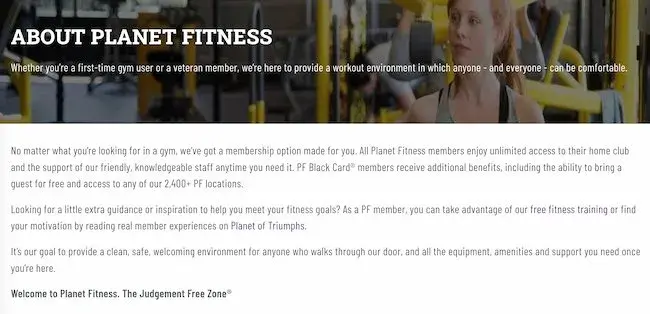
In Planet Fitness’ case, the brand did something no one else had done: Address the problem with the gym environment, not its users.
As you learn about what your audience wants, keep asking questions. How much do they know about your industry? What information do they need before making a purchase?
It‘s important to remember that your brand promise isn’t simply a slogan or commitment. It’s the first step in building a community with shared values. The better you understand your audience, the more likely you are to engage them.
If you haven’t already, develop buyer personas and workshop messages that could resonate with each persona.
Featured Resource: Make My Persona
2. Think about your customer touch points.
Your brand promise is your guarantee to customers.
Whether your customer is in-store, on social media, or buying online, place yourself in their shoes and envision how you want those interactions to go. Is there a specific feeling involved? What do they have to gain?
For example, say a customer spends a lot of time on your website but hasn‘t made a purchase. Do you know why they’re hesitating? If you were speaking to this customer in person, what would you say to help them move to the next step?
Once you put those feelings into words, you’ll be able to craft a brand promise that reflects the experience you want to promote.
As an exercise, you may find it useful to draft three or more secondary promises for each touch point. They can help you home in on your main brand promise and narrow your focus to how different touch points impact customer experience.
Your ultimate brand promise should be consistent across every touch point. So, the more time you spend looking at it from every angle, the more likely you are to create a powerful brand promise.
Featured Resource: Customer Journey Map Template
3. Keep it simple, unique, and inspiring.
Your brand promise should be clear and to the point — something you can say in one sentence. It won’t necessarily be as fun as a tagline, but it should definitely inspire trust and confidence.
Be thoughtful about which words you choose and who your audience is.
Does your brand promise need industry-specific terms? Is your brand promise about selling an offer or explaining your product? Answering these questions can help you find the right vocabulary for your promise.
Next, introduce some play into your writing. Think about your company culture, awakening the senses, and the details that can paint a picture for your audience.
This process will probably give you more copy than you need, but it can help you find an authentic and empathetic voice.
Then you can edit your brand promise into a single succinct statement that is useful, positive, and hopeful.
If you can‘t articulate your promise in this way, perhaps you haven’t fully fleshed out your brand’s purpose.
If that’s the case, start by asking yourself these questions:
- What should my customers expect from me?
- What does my company stand for?
- What makes us different from our competitors?
What makes a brand promise successful?
“A brand promise,” brand consultant Cornelis Jacobs tells me, “is basically your identity. If your brand didn’t exist, what would the world miss?”
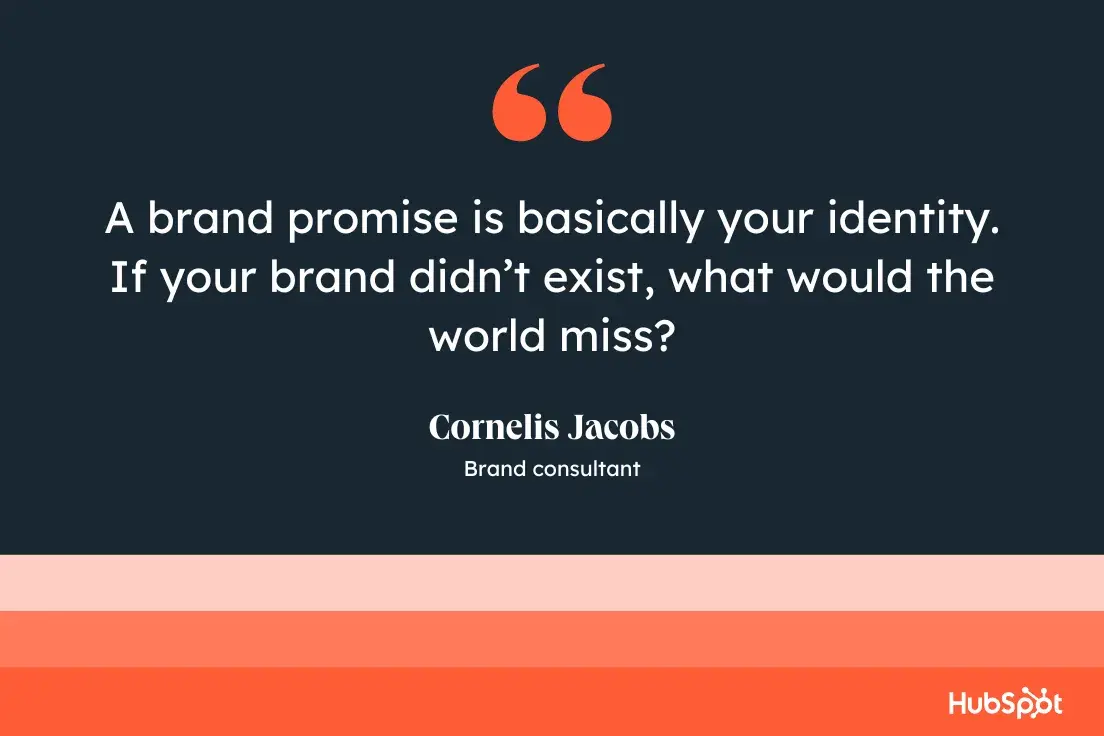
That world doesn’t have to be at a global scale — the target market for a corner bakery might be a single neighborhood. Whether you’re selling cupcakes or iPads, your brand promise has to create and nurture a relationship.
“It’s creating trust,” says Jacobs. “I give money in exchange for a product or service. There’s trust that the brand will deliver on that promise.” Jacobs sees two components to that trust: reliability and delight.
An inability to deliver on your brand promise — “that’s game over,” says Jacobs.
The long-term effects on brand perception can be devastating if you lose credibility by breaking a promise.
Here are four key elements to consider as you craft your brand promise:
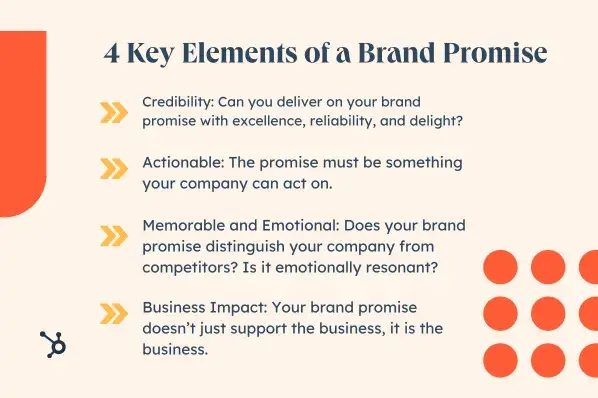
Credibility
Your brand promise should be something that your business or product is qualified to offer, and it should be something that you are able to deliver on with excellence, reliability, and delight.
Volvo’s brand promise, for example, hinges on safety. If it was unable to consistently engineer cars with high safety standards, it would lose all credibility.
This statement can also show your commitment to solving a specific problem for your customers.
Actionable
A brand promise is an offer that a business needs to keep. This means that the promise must be something your company can act on.
As you review your brand promise, ask yourself:
- Is your brand promise also a call-to-action?
- What do your customers get in return if they commit to your brand?
- How can your audience engage or get involved with your brand promise?
- What other questions might someone ask after seeing your brand promise?
To be effective, your brand promise needs to be something your stakeholders can act on or see you taking action on, plus why that action is valuable. If your promise is vague or static, you may need to keep working.
Memorable and Emotional
A brand promise “is emotive,” says Jacobs. “It’s not the mind; it’s the heart.”
To evoke strong emotions, ask yourself what emotions you want your customers or audience to feel when they solve a problem using your product or service.
This act of seeing from your customer’s perspective can help you create a “sticky” brand promise.
Business Impact
“Brand strategy is ultimately business strategy,” Jacobs tells me. “In economic terms, your brand is probably the single most important asset of any company.”
Your brand promise doesn’t just support what matters most to your business, it is the business.
That means that your brand promise has to be evident in every single touch point: what vendors you choose, what your website looks like, and even how you answer the phone. Jacobs says your brand promise is to “all stakeholders, not just your consumer.”
And there’s really only two options: “You either deliver on the promise, or you don’t.”
It might convey product excellence, drive sales, or expand brand influence. And as people in your organization make decisions, they should do so as champions of the brand.
Brand Promise Template
There isn‘t an exact formula to create your brand promise. But we’ve mentioned that it’s a blend of a few things that make up your company. So here’s a formula you can use to create your promise:
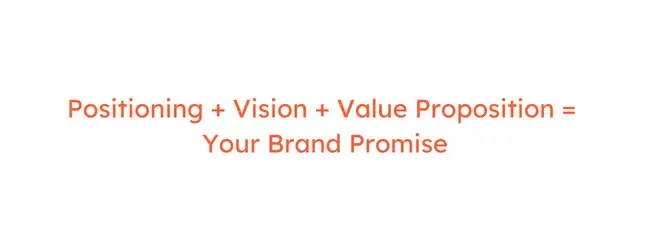
Positioning + Vision + Value Proposition = Your Brand Promise
Write your answers down and start blending these concepts together into one succinct idea.
Crafting your brand promise should be a top priority when developing your identity. Without this core message, you will likely struggle to develop your brand identity and strong messaging to connect with your target audience.
A pro tip from Jacobs: “A brand isn’t what you, the company, says it is. It’s what your customers say it is.”
Your brand promise should be so strong that “there should be no divergence” — that is, your customers should be able to describe your brand promise exactly as you do.
It may take a few sessions to flesh it out — and that’s okay. Because once you have it, it will become ingrained both internally and externally as your company grows.
Brand Promise Examples
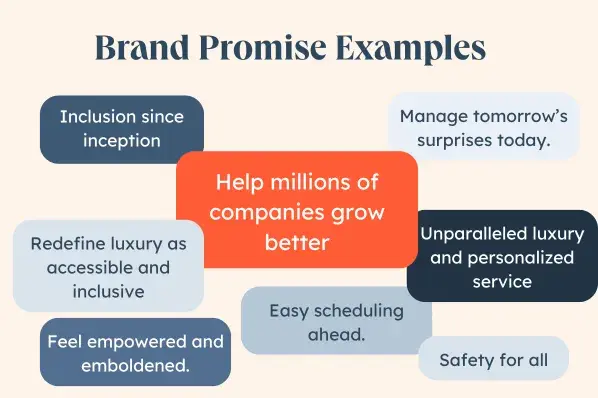
Keep in mind that some of these examples of brand promises are assumed and some have been shared by the companies (and a couple are completely fictional). Use them as inspiration when crafting your own.
To help you think about your own brand promise from multiple angles, I’ve also included hypothetical situations of what it might look like if some of these brands failed to deliver on their brand promises.
Build the best products in the world and enrich people’s lives. (Apple)
In a 2022 interview with Popular Mechanics, Apple CEO Tim Cook said that he tries to “carry on the mission that [Steve Jobs] set in place, to build the best products in the world that enrich people‘s lives. And that hasn’t changed. Lots of things change with time. But the reason for our being is the same.”
Well established as a design and product innovator, Apple’s brand promise is centered around innovation, quality, reliability, and user-friendly design.
If it couldn’t deliver on its brand promise, we might see Apple shipping shoddily designed products that don’t solve any problems for its consumers, something that would do swift and irreparable damage to its brand.
To inspire and nurture the human spirit — one person, one cup, one neighborhood at a time. (Starbucks)
Starbucks might even add “one street at time,” so ubiquitous are its stores across America and most corners of the globe.
Starbucks’ core brand promise is customer-focused, establishing its reputation as a customer service company that happens to sell coffee.
Feel empowered and emboldened. (Anima Iris)
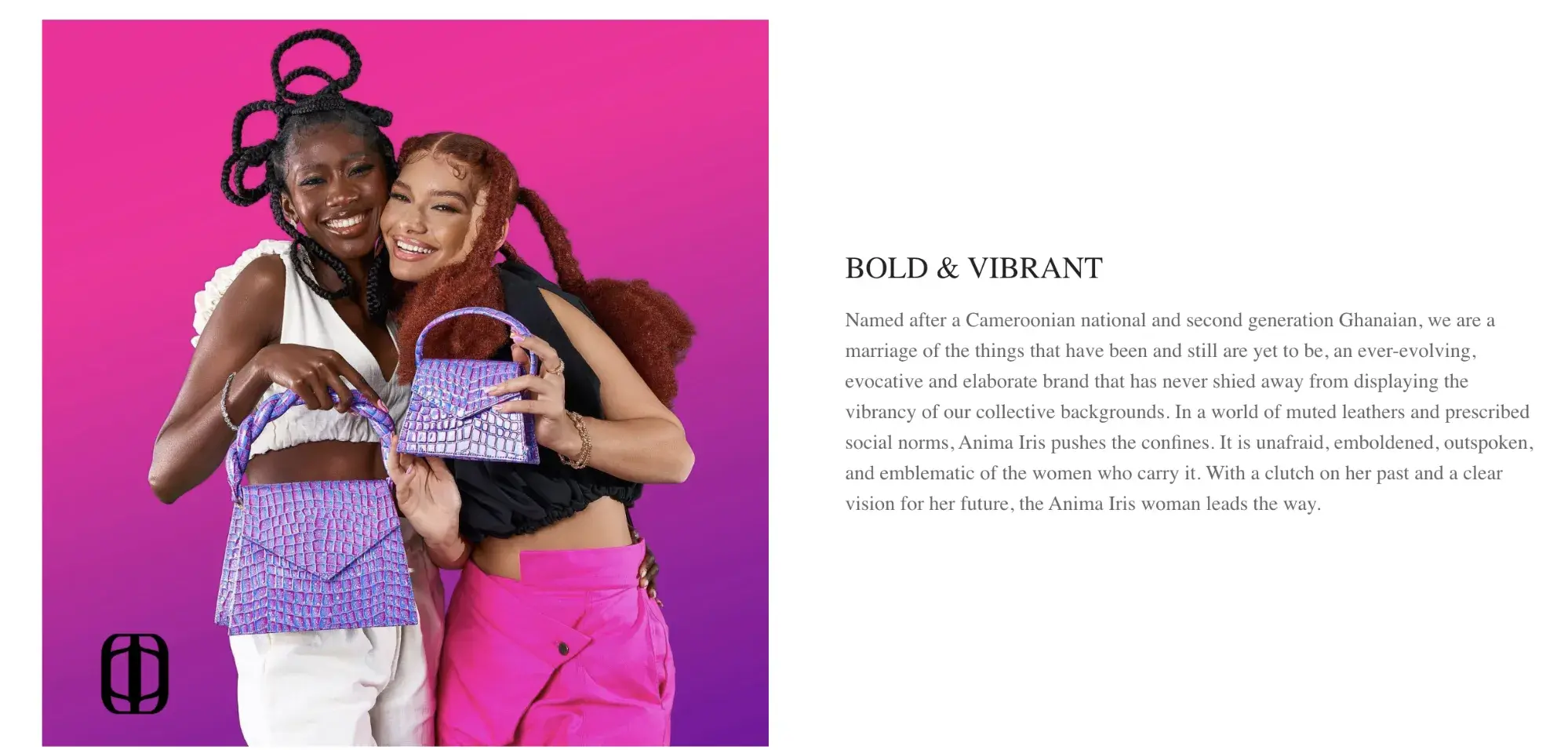
Image Source
Tennis accessories brand Anima Iris seeks an emotional connection with its target audience by promising that they will feel empowered and emboldened.
Those words also set it apart from competitors and establish some of the expectations its customers should have.
Redefine luxury as accessible and inclusive. (Telfar)
Telfar’s vegan leather shopping bags became a must-have accessory over the last decade or so, thanks to its positioning as an affordable luxury. That’s a tricky sweet spot to maintain, but it’s central to the brand promise.
If it failed to deliver on its brand promise, it could be reflected in prices shooting up beyond what its target consumers could afford, and/or a steep decline in quality.
Inclusion since inception. (Tru Colour)
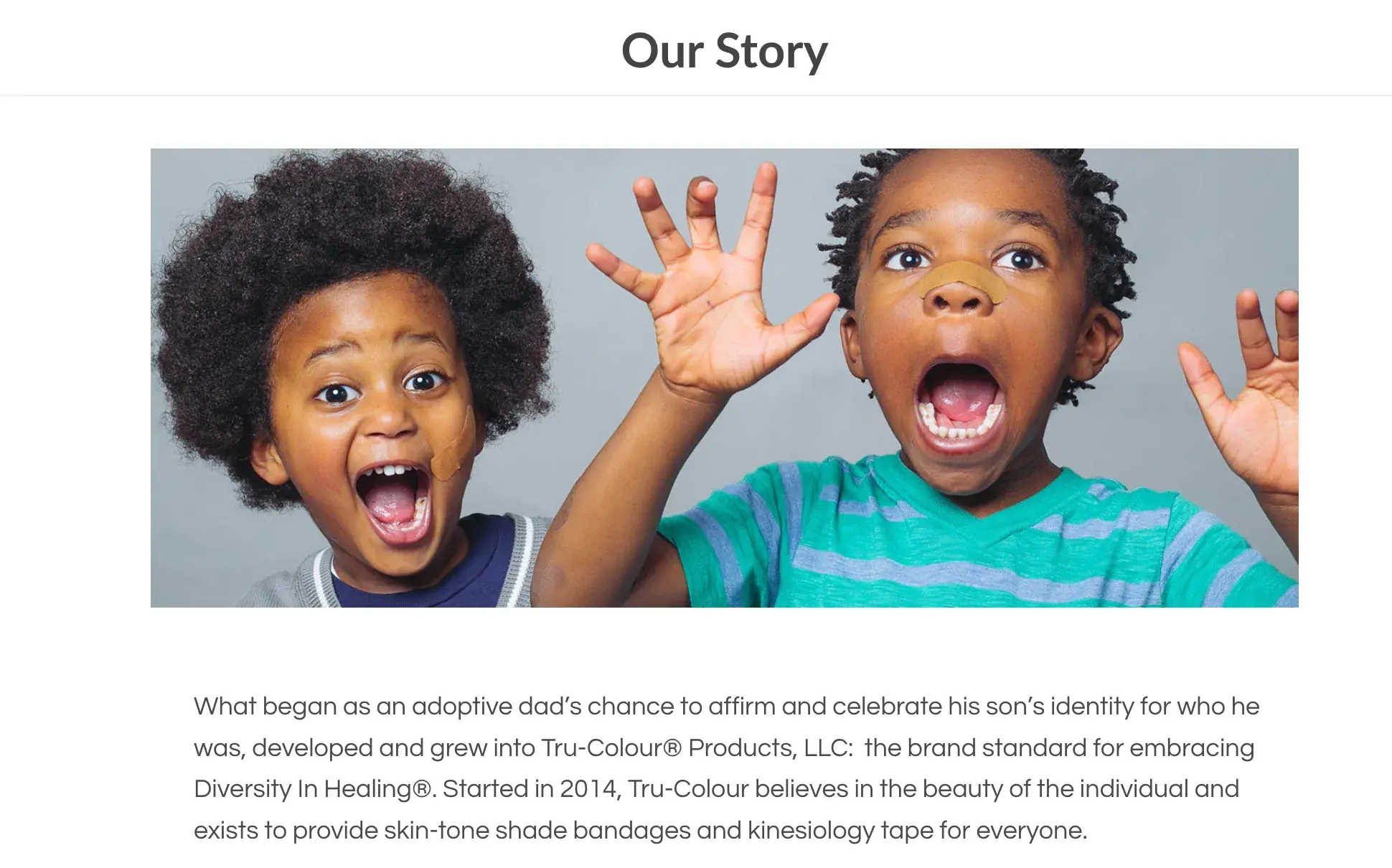
Image Source
Rooted firmly in diversity and inclusion, Tru Colour “believes in the beauty of the individual and exists to provide skin-tone shade bandages and kinesiology tape for everyone.”
Its brand promise indicates that inclusion is a foundational principle, one that will continue to drive the brand as it grows.
Create a safe space for POC to travel and discover new adventures. (Noirbnb)
The stakes are high for Noirbnb, which promises “a safe space for people of color to travel and discover new adventures.”
As such, it’s also a memorable brand promise, particularly for its target audience of people of color who may have felt unsafe on previous travel adventures. This is also a highly actionable brand promise.
Safety for all. (Volvo)

Image Source
Volvo’s EVA initiative prioritizes Equal Vehicles for All, “regardless of gender, age, height, weight, or shape.”
If you’ve ever buckled up in a car to find the seat belt at throat height, Volvo’s promise will pique your interest.
This is another highly actionable brand promise, since the burden of proof — and literal life-or-death stakes — rests on Volvo.
Unparalleled luxury and personalized service. (Four Seasons)
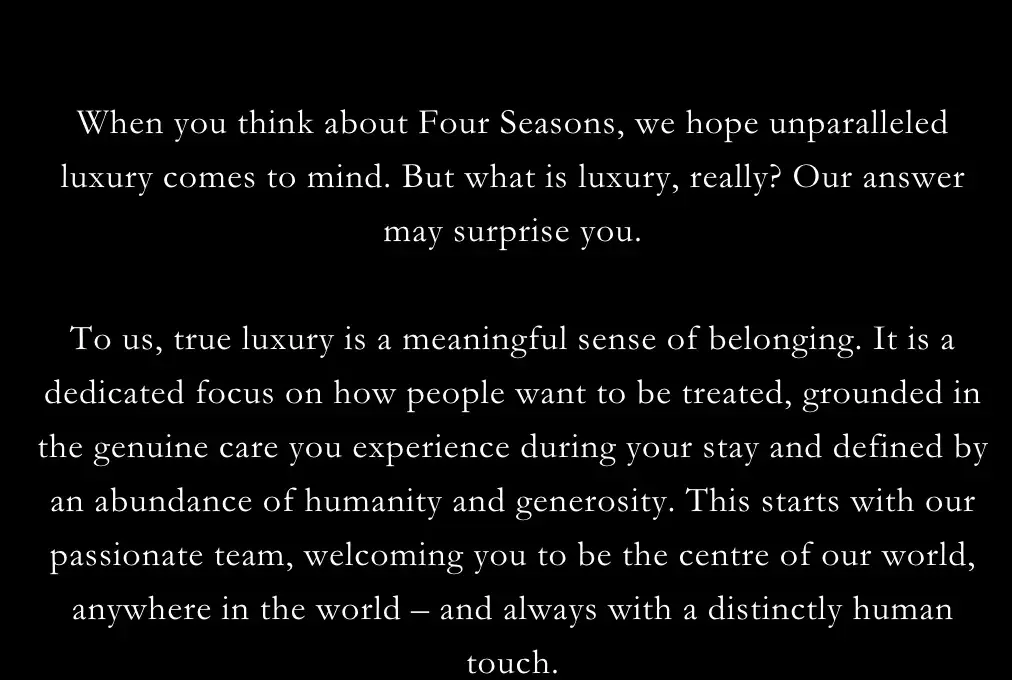
Image Source
When your name is synonymous with luxury, you’d best be able to deliver on your brand promise.
Customers of Four Seasons properties expect a level of personalized service that sets the brand apart not only from other hotels and resorts, but from other luxury hotel brands. This brand promise is memorable and emotional, appealing to consumers’ desire to be treated like royalty.
Bring stories to life — safely. (Inkheart)
Pretend I’ve been handed the money and the magic needed to build an adventure tour company for fictional places.
My imaginary company is inspired by Cornelia Funke’s 2003 YA book Inkheart, in which a girl learns that her father can bring characters to life simply by reading from them.
Inkheart’s brand promise, “Bring stories to life — safely,” assures its imaginary audience that they can enjoy immersive experiences in their favorite fictional worlds without fear of ogres, vampires, or evil masterminds.
We scare because we care. (Monsters Inc.)
A real brand promise from a fictional brand, Disney Pixar animated classic Monsters Inc. features a company by the same name. Monsters Inc. employs monsters to scare children, whose screams produce clean energy.
Doing double duty as a tagline, “We scare because we care” evokes emotion and establishes the brand’s distinctiveness — while promising legitimate frights.
What‘s common across all these promises is that they never refer to a particular offering or numerical goal. Instead, they are statements that encompass the brand’s broader purpose.
Examples of Brand Promises for B2B
Business-to-business brand promises can be difficult to craft. This is because these relationships are often more about efficiency and ROI than meeting emotional needs.
Check out these B2B brand promise examples to spark your imagination.
Help millions of companies grow better. (HubSpot)
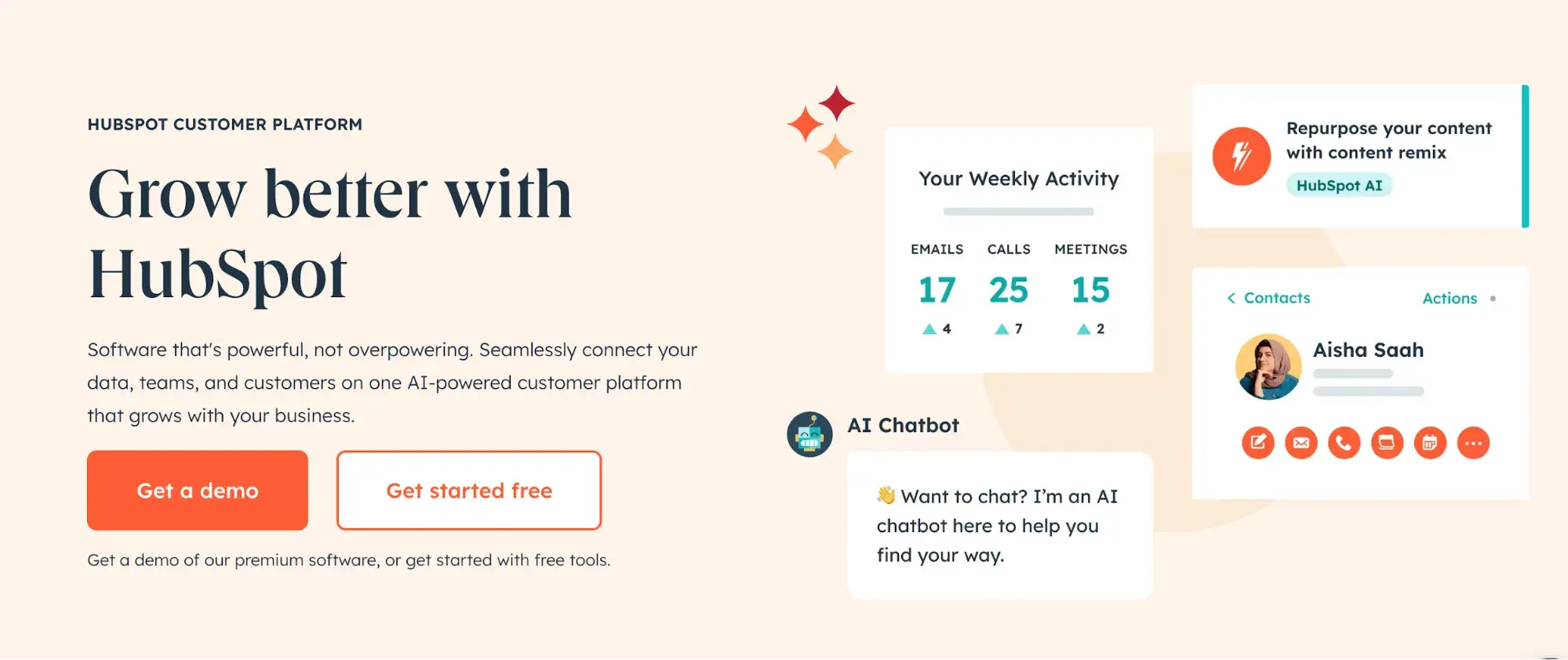
Image Source
Here at HubSpot, we offer a complete customer platform that helps businesses connect and grow better. (Psst, that customer platform includes Marketing Hub.)
Our brand promise has broad appeal — “millions of companies” — and demonstrates our commitment to and focus on growth.
See inside any stack, any app, at any scale, anywhere. (Datadog)
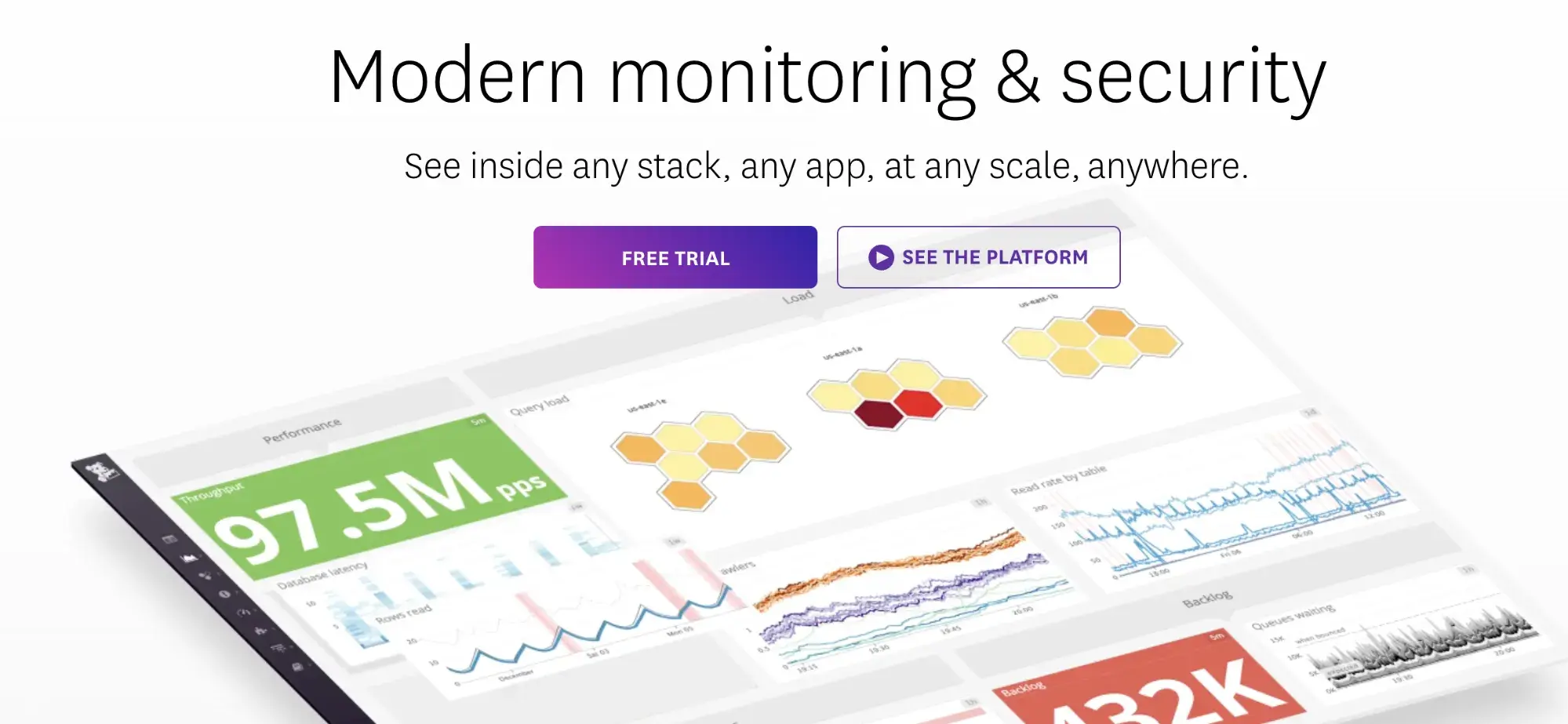
Image Source
The repeated “any” in Datadog’s brand promise indicates the product’s flexibility, an actionable claim that also differentiates it from its competitors.
Keep a good thing growing. (Recurly)
Recurly, a subscription management service, makes an emotional appeal in its brand promise with the word “growing.” That sense of nurturing is backed up by the actionable claim that it has “a good thing.”
Easy scheduling ahead. (Calendly)
I use Calendly regularly, and I appreciate that it’s simple to use. Calendly’s brand promise focuses on a positive user experience, which directly impact’s the brand’s bottom line.
Unlock the power of gifting at scale. (Reachdesk)
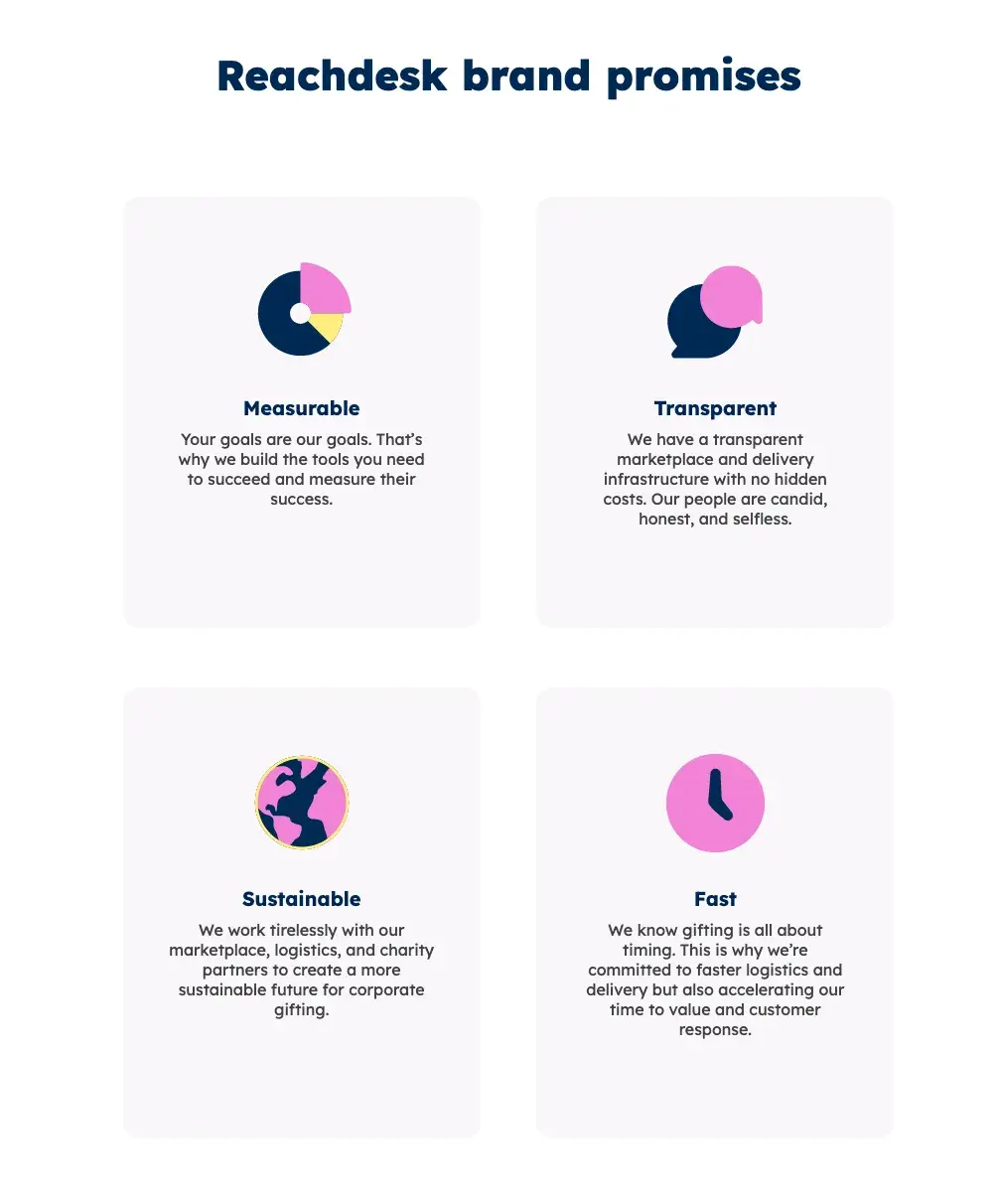
Image Source
Reachdesk uses AI to power personalized corporate gifting. Its brand promise hints at the “power” in store for companies that wow and delight their customers.
If it couldn’t deliver on its brand promise: Glitchy AI could lead to gifts that didn’t feel thoughtful or personal, or worse, be embarrassing.
Manage tomorrow’s surprises today. (LogicManager)
LogicManager uses the word “surprises” to indicate that it understands the realities of risk management. That establishes an emotional relationship with its customers — it’s that “hey, you get me” moment.
That emotional plea is backed up by a credible and actionable promise that the enterprise risk management company can predict future risks before they get out of control.
Smarter PR with powerful, easy-to-use software. (Muck Rack)
Muck Rack’s brand promise begins with a superlative, “smarter,” appealing to customers’ desires for growth and improvement. Coupled with “powerful” and “easy-to-use,” Muck Rack sets up an actionable brand promise.
Engineering the extraordinary to alleviate pain, restore health, and extend life. (Medtronic)
Medtronic, a healthcare tech company, has to persuade potential customers that it can improve (and even extend) quality of life with devices like high-tech pacemakers. That’s a high bar to clear, so it goes straight for an emotional appeal with a brand promise that uses strong verbs like “alleviate” and “restore.”
Empowering small businesses and entrepreneurs with financial tools and services that are accessible, innovative, and user-friendly. (Square)
If you’ve interacted with small businesses, like your neighborhood bookstore or a vendor at the local farmers’ market, you’ve likely used Square to make a payment. Square’s brand promise hinges on accessibility and user-friendliness above all — an inability to deliver would make it unusable by the audience it targets.
Build Your Brand Promise for Lasting Results
Some promises last a lifetime. To make sure that you’re creating a brand promise for the long haul, don’t rush through the process.
Drafting a quick slogan is tempting when your team is up against a deadline — but this is a promise to your all your stakeholders, so consider it carefully.
Take a look at the tips, templates, and examples above, and let your creativity run wild. Your brand may already have a strong identity, but how are you committing to your customers? Tell them today, with your brand promise.
![]()
این خبر را در ایران وب سازان مرجع وب و فناوری دنبال کنید
جهت دانلود و یا توضیحات بیشتر اینجا را کلیک نمایید